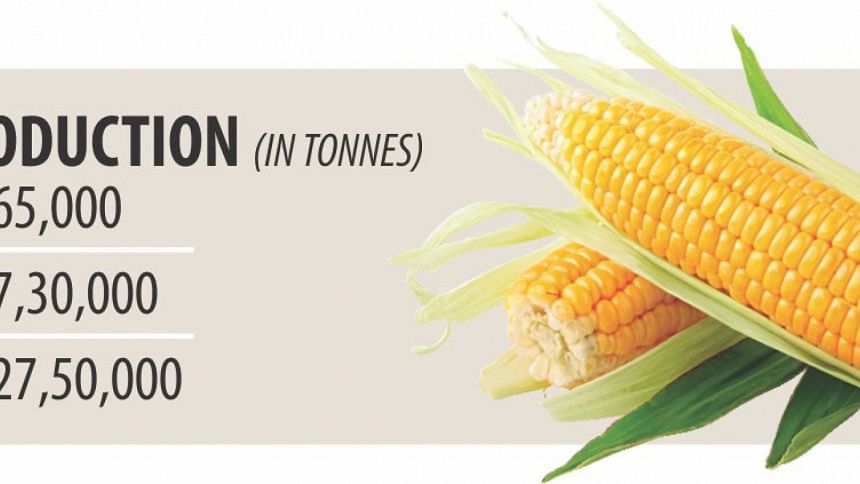Amazing growth in maize output

Subtly and silently maize, also known as corn, has emerged as the most important cereal crop after rice in Bangladesh, relegating wheat to third.
Country's annual maize output reached the new high of 2.75 million tonnes in 2015-16 and 90 percent of the home-grown maize is feeding a burgeoning poultry and fish feed industry.
With over 34 million tonnes of annual rice output, Bangladesh is now self-sufficient in the staple while the country largely depends on imports to meet over five million tonnes of yearly wheat requirements.
Domestic production of wheat hovers around one to 1.3 million tonnes only, depending on weather and acreage factors. Last season's wheat crop suffered a blow due to wheat blast -- a fungal attack that Bangladesh experienced for the first time.
Since the inception of commercial farming of maize in Bangladesh in mid-90's, its yearly output has grown from a paltry 65,000 tonnes in 1997-98 to 2.75 million tonnes in the last fiscal year, making it the fastest expanding cereal in the country.
Policy planners, breeders and market sources attributed the amazing rise in maize production to a number factors; demand from feed industry, farmers' comparative advantage in terms of profits, less irrigation requirements, availability of both home-grown and imported hybrid seeds with high yield potentials, and overall policy and research support.
Though the maize revolution came hand in hand with the rise of poultry and fish feed industry, government is now trying to promote maize not just as a feed crop, but also as food crop.
Agriculture Minister Matia Chowdhury told The Daily Star, "Maize is rich in Vitamin-A. We've promoted production of mixed flours of maize and wheat. Our people will accept roti [homemade flattened bread] made from maize flour, if it can be made sticky like wheat flour."
"I'll be requesting CIMMYT [International Maize and Wheat Improvement Center] to go for genetic interventions so that glutinous maize varieties can be made available," Matia said yesterday before leaving for Mexico to join the 50-year celebrations of the foundation of CIMMYT, world's premier maize and wheat research institute.
Maize is the world's number one cereal crop with a global production of one billion tonnes followed by rice and wheat with an average annual output of around 700 million tonnes each.
Amiruzzaman, a chief scientific officer of Bangladesh Agricultural Research Institute (Bari) heads the institute's Plant Breeding Division (PBD). He has been following the research and field-level developments of maize cultivation in Bangladesh for years.
He said while farmers hardly make any profit by cultivating high investment-intensive winter rice, Boro, their profit from maize is quite significant. Over 3,000 litres of water is required for every kilogram of Boro output but maize requires only 700 litres, he added.
According to a recent US Department of Agriculture's (USDA) report, farmers in Bangladesh earn over $2,275 by investing $1,421 for every hectare of maize. Boro fetches them $1,081 against an investment of $1,319, a loss-making project, it claimed.
And comparing to maize, growing wheat is less profitable too. Farmers can earn a little over $823 from per hectare of wheat farming with an investment of $663, stated the USDA report “Bangladesh: Grain and Feed Annual 2016”.
"The gross margin from maize sales, per hectare, is 2.4 times greater than that of wheat or rice. Maize also has fewer pest and disease problems," said a report of the UN Food and Agriculture Organisation (FAO). It also notes, "By shifting from rice to maize during the dry season, farmers save groundwater from over-exploitation."
Thanks to imports and developments of hybrid seeds, average maize yield in Bangladesh is now over seven tonnes per hectare. Rice yields four tonnes and wheat three to 3.5 tonnes.
Bari has developed as many as 22 maize varieties, 13 of them hybrid with some having yield potentials as high as 10 tonnes a hectare. Currently, over a quarter of maize seeds' requirements are met by the home-grown ones while the rest are imported.
After the release of the Bari Hybrid Bhutta-11 in 2008, the country's premier agro-research institution came up with two more varieties, Bari Hybrid Bhutta-12 and -13, this year.
Amiruzzaman said these varieties were Barendra region's answers to water scarcity. Farmers who cannot grow Boro due to water crisis can grow these new hybrid maize varieties, which require little water, he explained.
He said the government was trying to promote maize also in the salinity-hit regions of the South. "We're developing salt-tolerant maize varieties and expecting some significant progress in this regard in two years."
He said instead of cultivating Boro, many northern farmers are going for potatoes and then they reap the crop early to make best use of the fertiliser residues for cultivating maize for less cost.
As the country is approaching the three million tonnes mark in maize production, Matia said, "By now we could have probably reached six million tonnes, had there been no hiccup in poultry industry due to avian influenza [bird flu]."
It is evident from production statistics.
Maize production had a sustained growth until the fiscal year 2007-08 when the yearly output rose to 1.34 million tonnes but bird flu-induced demand slump in feed industry brought the maize output down to 0.73 million tonnes in the very next year.

 For all latest news, follow The Daily Star's Google News channel.
For all latest news, follow The Daily Star's Google News channel. 



Comments